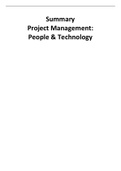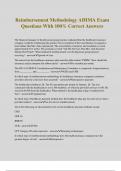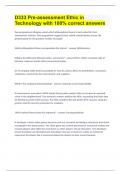Summary
Project Management:
People & Technology
,Table of Contents
Lecture 1: Introduction............................................................................................................................ 1
1.1. Planning & scheduling .................................................................................................................. 6
Lecture 2: Software development ........................................................................................................... 8
2.1. Requirements engineering ......................................................................................................... 12
Lecture 3: Business case and software costs estimation ...................................................................... 15
3.1. Software cost estimation ........................................................................................................... 20
3.2. Measuring the success of pilot projects ..................................................................................... 23
Lecture 4: Agile & DevOps ..................................................................................................................... 24
4.1. Agile project management ......................................................................................................... 29
4.2. DevOps ....................................................................................................................................... 31
4.3. Open source software development .......................................................................................... 33
Lecture 5: Stakeholders and support .................................................................................................... 38
5.1. Risk management ....................................................................................................................... 42
Guest lecture 1: KPMG .......................................................................................................................... 44
Guest lecture 2: Rabobank .................................................................................................................... 48
,Lecture 1: Introduction
Project: a temporary endeavour to create a unique product, service or result. Differs from a process.
A project is temporary and has a clear start- and end-point. A project has a limited budget: resources
or people are only temporarily allocated to a project. By contrast, a business process is a ‘standing
operation’ with a stable budget and stable roles.
Software project management: is concerned with activities to
ensure that software is delivered on time, within budget and in
accordance with the scope or requirements of the organization
that needs the software. Also known as Devil’s Triangle.
Developing software is hard:
Manifesto for Agile Software Development:
• Individuals and interactions over processes and tools.
• Working software over comprehensive documentation.
• Customer collaboration over contract negotiation.
• Responding to change over following a plan.
Why agile now?:
• Agile practices “include scrum, which emphasizes creative and adaptive teamwork in solving
complex problems. Lean development, which focuses on the continual elimination of waste.
Kanban, which concentrates on reducing lead times and work in process.” (p4)
• “Now agile methodologies … are spreading across a broad range of industries and functions
and even into the C-suite” (p1).
• But … executives know little about agile (p2), so … “with the best of intentions, erode the
benefits that agile innovation can deliver” (p3)
• “Companies need not just new products and services but also innovation in functional
processes [..]. Companies that create an environment in which agile flourishes find that teams
can churn out innovations faster in both those categories”.
2 key questions for this course:
• Why does agile work when it does?
• Under what circumstances does agile work?
IT-project success: in line with the Devil’s Triangle.
1
, Is agile a fashion (Cram & Newell, 2016)?: agile has (or can have) all the potential characteristics of a
fashion:
1. Norm of progress: new management techniques will be adopted because they are seen as
novel innovations.
2. Norm of rationality: new management techniques will be adopted when they are presented
by others as representing the most efficient approach available.
3. Socio-psychological forces: the demand for management innovations will increase when they
are perceived as fulfilling individuals’ psychological needs.
4. Techno-economic forces: the demand for management innovations will increase when they
are perceived as being consistent with economic fluctuations, political perspectives, and
organizational structure or culture.
5. Innovation devolution: a management technique that begins as an authentic technical
intervention, but devolves into ambiguous and dubious inventions that provide little value
aside from perceived legitimacy.
Three ways to do agile:
• Crusaders: exclusively adopt agile in a pure form.
• Tailors: integrate agile and traditional approach to fit specific circumstances.
• Dabblers: ceremonial agile activities along traditional approach.
o Example: only doing stand-up meetings for the ‘looks'. The core stays traditional.
Why is developing IT for government hard (Elias Committee, 2014)?:
• National government is not ‘in control’ regarding ICT projects.
• Politicians do not realize, but ICT is everywhere.
• National government does not fulfil her ICT policy objectives.
• The accountability and decision making structure is deficient.
• Government has insufficient insight in costs and benefits of ICT.
• ICT knowledge of the national government is lacking.
• ICT project management is weak.
• ICT bid-for-tender procedures contain perverse incentives.
• Management of contracts in ICT-projects is not professional.
• National government lacks the necessary learning ability.
Design cycle: the general idea is that design
and development is an iterative process
where you learn from mistakes, re-think and
improve. Nothing goes perfect the first try.
When you build software, you go through
four different activities. You do not need to
do them in order, but instead you can also do
them in parallel. Each affects others.
• Analyze.
• Design.
• Implement.
• Test.
2
Project Management:
People & Technology
,Table of Contents
Lecture 1: Introduction............................................................................................................................ 1
1.1. Planning & scheduling .................................................................................................................. 6
Lecture 2: Software development ........................................................................................................... 8
2.1. Requirements engineering ......................................................................................................... 12
Lecture 3: Business case and software costs estimation ...................................................................... 15
3.1. Software cost estimation ........................................................................................................... 20
3.2. Measuring the success of pilot projects ..................................................................................... 23
Lecture 4: Agile & DevOps ..................................................................................................................... 24
4.1. Agile project management ......................................................................................................... 29
4.2. DevOps ....................................................................................................................................... 31
4.3. Open source software development .......................................................................................... 33
Lecture 5: Stakeholders and support .................................................................................................... 38
5.1. Risk management ....................................................................................................................... 42
Guest lecture 1: KPMG .......................................................................................................................... 44
Guest lecture 2: Rabobank .................................................................................................................... 48
,Lecture 1: Introduction
Project: a temporary endeavour to create a unique product, service or result. Differs from a process.
A project is temporary and has a clear start- and end-point. A project has a limited budget: resources
or people are only temporarily allocated to a project. By contrast, a business process is a ‘standing
operation’ with a stable budget and stable roles.
Software project management: is concerned with activities to
ensure that software is delivered on time, within budget and in
accordance with the scope or requirements of the organization
that needs the software. Also known as Devil’s Triangle.
Developing software is hard:
Manifesto for Agile Software Development:
• Individuals and interactions over processes and tools.
• Working software over comprehensive documentation.
• Customer collaboration over contract negotiation.
• Responding to change over following a plan.
Why agile now?:
• Agile practices “include scrum, which emphasizes creative and adaptive teamwork in solving
complex problems. Lean development, which focuses on the continual elimination of waste.
Kanban, which concentrates on reducing lead times and work in process.” (p4)
• “Now agile methodologies … are spreading across a broad range of industries and functions
and even into the C-suite” (p1).
• But … executives know little about agile (p2), so … “with the best of intentions, erode the
benefits that agile innovation can deliver” (p3)
• “Companies need not just new products and services but also innovation in functional
processes [..]. Companies that create an environment in which agile flourishes find that teams
can churn out innovations faster in both those categories”.
2 key questions for this course:
• Why does agile work when it does?
• Under what circumstances does agile work?
IT-project success: in line with the Devil’s Triangle.
1
, Is agile a fashion (Cram & Newell, 2016)?: agile has (or can have) all the potential characteristics of a
fashion:
1. Norm of progress: new management techniques will be adopted because they are seen as
novel innovations.
2. Norm of rationality: new management techniques will be adopted when they are presented
by others as representing the most efficient approach available.
3. Socio-psychological forces: the demand for management innovations will increase when they
are perceived as fulfilling individuals’ psychological needs.
4. Techno-economic forces: the demand for management innovations will increase when they
are perceived as being consistent with economic fluctuations, political perspectives, and
organizational structure or culture.
5. Innovation devolution: a management technique that begins as an authentic technical
intervention, but devolves into ambiguous and dubious inventions that provide little value
aside from perceived legitimacy.
Three ways to do agile:
• Crusaders: exclusively adopt agile in a pure form.
• Tailors: integrate agile and traditional approach to fit specific circumstances.
• Dabblers: ceremonial agile activities along traditional approach.
o Example: only doing stand-up meetings for the ‘looks'. The core stays traditional.
Why is developing IT for government hard (Elias Committee, 2014)?:
• National government is not ‘in control’ regarding ICT projects.
• Politicians do not realize, but ICT is everywhere.
• National government does not fulfil her ICT policy objectives.
• The accountability and decision making structure is deficient.
• Government has insufficient insight in costs and benefits of ICT.
• ICT knowledge of the national government is lacking.
• ICT project management is weak.
• ICT bid-for-tender procedures contain perverse incentives.
• Management of contracts in ICT-projects is not professional.
• National government lacks the necessary learning ability.
Design cycle: the general idea is that design
and development is an iterative process
where you learn from mistakes, re-think and
improve. Nothing goes perfect the first try.
When you build software, you go through
four different activities. You do not need to
do them in order, but instead you can also do
them in parallel. Each affects others.
• Analyze.
• Design.
• Implement.
• Test.
2




